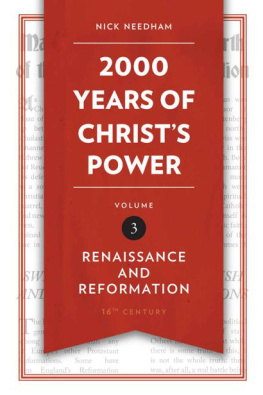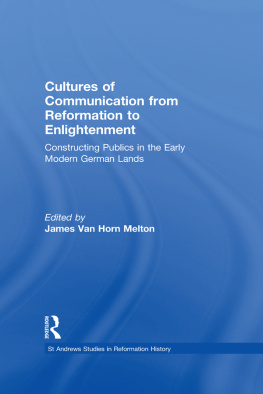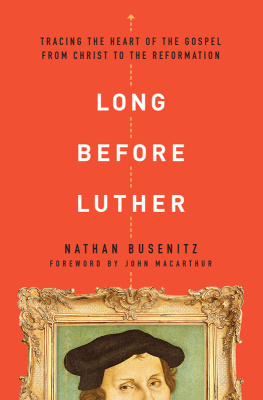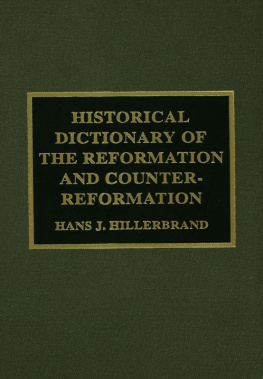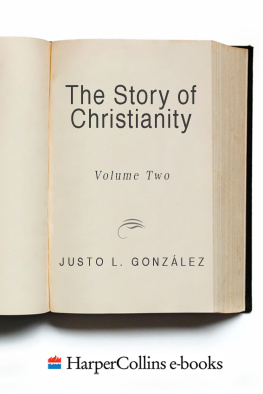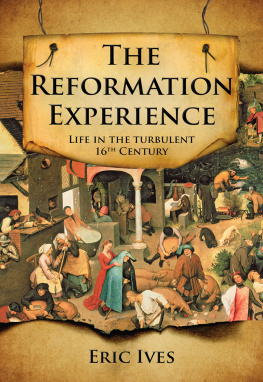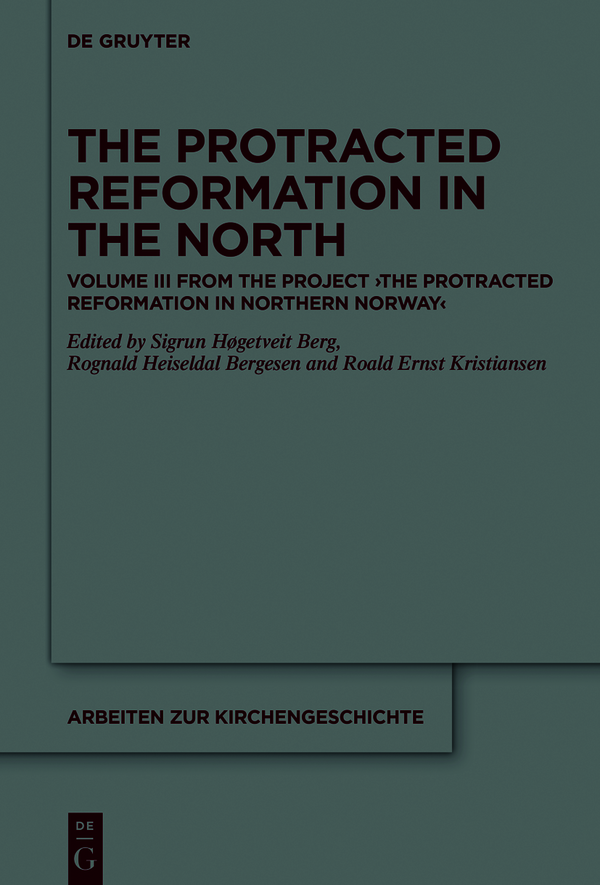Arbeiten zur Kirchengeschichte
Edited by
Karl Holl
Hans Lietzmann
Christian Albrecht
Christoph Markschies
Christopher Ocker
Volume
ISBN 9783110685992
e-ISBN (PDF) 9783110686210
e-ISBN (EPUB) 9783110686289
Bibliographic information published by the Deutsche Nationalbibliothek
The Deutsche Nationalbibliothek lists this publication in the Deutsche Nationalbibliografie; detailed bibliographic data are available on the Internet at http://dnb.dnb.de.
2020 Walter de Gruyter GmbH, Berlin/Boston
Introduction
Lars Ivar Hansen
Sigrun Hgetveit Berg
The Reformation has been studied using a variety of disciplinary approaches, and from different chronological perspectives using both shorter and longer time frames and perspectives. Some studies have concentrated on religious change, focusing upon questions of faith and confessionalization, and others on political events, such as the initiatives of various states for reorganizing the church as a part of governmental administration. Some have focused upon the conditions developing during the fifteenth century and leading up to Martin Luthers initiative as a final climax, while others have taken Luther as a starting point for a new beginning.
Regarding Norway specifically, the Reformation is inseparably attached to the loss of national independence and sovereignty in 1536/37, when the Lutheran king Christian III of Denmark seized the control of the Norwegian Council of the Realm, Norways instrument of national sovereignty. In his electoral capitulation to the Danish nobility, Christian III stated that Norway should no longer be an independent kingdom, but be completely integrated as a province of Denmark. Archbishop Olav Engelbrektsson, who had been the head of the Norwegian Council of the Realm, had to flee the country after having tried to resist individual Danish noblemen trying to exert control over the council. Thus, the Reformation in Norway was introduced from abroad, with very little preparation in advance, such as critique of religious practices by popular movements or contributions from intellectual elite.
The fact that the Reformation in Norway represented a sudden and qualitative change in both the political and governmental, as well as the religious, confessional sphere, has led to certain consequences regarding the research history. After Denmark had to cede Norway to Sweden in 1814, the main task of general historians became contributing to the nation-building process and investigating the transition process from the separate, medieval Norwegian monarchy unified with the other Nordic states during the Kalmar Union (1389/13971521) to becoming a part of Denmark in 1536. For their part, church historians and theologians were more interested in questions of dogmatism, relating to Lutheran confessionalism, partly influenced by the lay movements that developed. Although a certain division of labor and research occurred between general historians and church historians / theologians, both groups seem to have had a more or less explicitly positive view of the Lutheran Reformation,
During the twentieth century, and in particular during the last decades, a change in these dividing lines between the disciplines occurred, and scholars have begun to ask new questions and define the research fields in different ways. In particular, the so-called cultural turn has had great implications, focusing on questions of mentality, and about the meaning and significance of the material and institutional changes that society had undergone. This attention has facilitated a new, broader picture of the consequences of the Reformation, with an emphasis on both the political and theological / confessional fields. Both historians and theologians now pose new questions and approach old subjects in a new way concerning the events that led up to the Reformation, as well as the consequences afterwards.
Instead of focusing research on the implementation of the Reformation in ones own nation, there is now a tendency to question the notion that the Reformation followed more or less the same development in the various European nation-states as in the country of its origin. The same goes for regional variations. This shift enables more comparative and multidisciplinary approaches to the various developments in neighboring countries, as documented in the unpublished Report to the 28th Congress of Nordic Historians in Joensuu 2014, with the title The Long Reformation in Nordic Historical Research, edited by Per Ingesman.
Thus, contemporary research on Reformation processes tends to emphasize the long-term consequences of the political and religious upheavals of early sixteenth-century Europe. This has also been the approach applied throughout the project from which this anthology stems, The Protracted Reformation in Northern Norway. Its basic premise has been that the Reformation in the high north is most fruitfully studied by applying a perspective that takes into consideration the long-term conditions preceding the Reformation, as well as the long-term consequences stemming from the implementation of the Reformation in this region. It has focused on several processes both political development and religious change and to a certain degree applied a trans-national perspective, trying to compare the developments in various parts of northern Fennoscandia.
Two anthologies were published earlier as part of the project. The first one contains articles highlighting and analyzing the main thematic fields focused on in the project: (1) the church from an organizational and political perspective, (2) the role of church art and liturgy, (3) church library studies, (4) the post-Reformation priesthoods material conditions, social position, and role in the reception and interpretation of the Reformation for the ordinary people, and (5) the relations vis--vis the Smi and mission initiatives towards the Smi during the 1600s and 1700s.
In addition, it contains comparative and supplementary contributions: an overview over the research literature concerning the Reformation process in Germany, a comparison with Patriarch Nikons church reform in Russia, a comparative analysis of the Reformation decades in the Norwegian-Swedish border region Jmtland, and the Norwegian legal court practice relating to sexual crimes before and after the Reformation.
The second volume is more concentrated on the topics of confessionalization and the relations between the various peoples in northern Fennoscandia conceived as processes of othering, that is, constructing roles and models of the different peoples as the Other, with whom one should cooperate or from whom one should delimit oneself. The contributions are arranged according to four themes: (1) confessionalization, (2) the conditions of the priesthood after the Reformation, (3) northern European views of Russian orthodoxy, and (4) the relationship of the Smi with church and state authorities.
The Northernmost Reformation
A series of contextual reasons exist for applying such a long-range perspective when studying the Reformation processes in the northernmost parts of Scandinavia.
First of all, this northernmost area appeared at the time as a multi-ethnic, borderless region. It was inhabited by several peoples (Norwegians, Swedes, Smi, Finnlanders, Kvens, Russians, and Karelians), but the emerging and expanding nation-states with governmental centers further south had not yet succeeded in drawing exact borders between their separate areas of administration and jurisdiction. Nevertheless, a large portion of the population, that is, the Smi, was subjected to common taxation by all three surrounding and expanding nation-states: the monarchies




